Medellin was notoriously known for being the most dangerous city in the world during the 1980’s and 90’s because it was ruled by Pablo Escobar's Medellin cocaine
cartel. Today the city is a thriving place and safe for travellers and the crime rate has decreased tremendously since the Escobar days. Before arriving, we had heard about backpackers visiting Pablo’s grave and I was
appalled that someone would take the time to visit a dead drug baron. The next thing I know we have met some great people in our hostel and my arm has been twisted to go on a Pablo Escobar tour! I have no idea what I was thinking
by agreeing to it but decided to give it a go anyway, if only to learn more about the notorious gangster. It was to be a very surreal day.
Our guide, Isabelle, filled us in on the background of the Escobar family and how Pablo became a drug baron, one of the richest men in the world and a notorious outlaw, along
with telling us that the tour is approved by the Escobar family who receive money from the tour company much to my horror, what a great start.
During the tour we visited Pablo’s former house in the centre of Medellin, a huge complex that was filled with luxury goods and art work that also had his surname displayed
down the side of the building in big letters to let everyone know he lived there.

We were also taken to view the building where Pablo was shot dead on the rooftop in 1993 after hiding for 500 days from the police and the
CIA after escaping from house arrest, although it’s still unclear whether he was killed by the police or by a bullet from his own gun. Our guide said she doesn’t know who to believe. Most of the stories she told us were
from the Escobar family’s point of view, but she thinks the family are full of lies and doesn’t believe what they say.
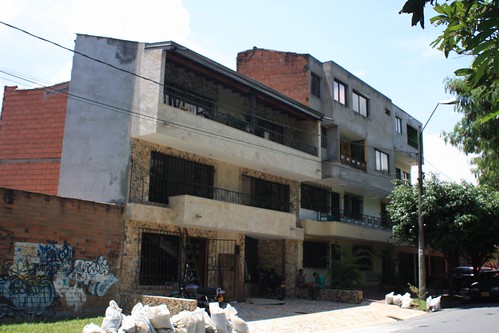
We were then taken to Pablo’s family grave site and it was here that we discovered that the driver of our tour, Mario, who didn’t want any pictures taken
of himself because he is a very discreet man, worked for the Escobar cartel for 30 years and as Pablo’s personal driver for the last 5 years of Pablo’s life! This was turning into a surreal day just knowing that the person
driving you around had not only driven for Pablo but had also driven assassins and huge quantities of drugs around for the cartel. We showed this man a lot of respect and laughed at all his jokes, I think out of fear.
Mario showed us the graves of other people who worked in the cartel, especially one of a man who became Pablo’s head of assassins and chief torturer just at the age of 16 because he was good at killing! Mario told us stories
about all the men buried around us in the cemetery, most of who died in their twenties either by torture or in gunfights, all very surreal.

To his credit, the driver admitted that if he had known how dangerous his work would have become he would never have joined the cartel and he was shot and wounded on numerous occasions.
His biggest regret was driving an assassin to kill his best friend who had betrayed Pablo. He really wanted to warn his friend but knew he would also be killed if he did so. When Pablo died, he approached the Cali cartel,
the Escobar’s rivals, and told them he didn’t want to work for them or any other cartel anymore and if they didn’t like that then they could kill him. They let him go free, and today he is a family man and drives a school
bus for a living when not working on the tours.
The finale of the tour was to visit the home of and meet with Roberto Escobar, Pablo’s brother and the accountant for the cartel!!! This just topped off the surrealism of
the day. There was Roberto on the door step waiting to greet us into his home. He took us on a tour of his house and showed us furniture with false backs where they hid money from the police. He showed us cars with double
chassis that they used to hide drugs in and a bullet proof Chevy with holes inside the doors for them to fire their guns through.
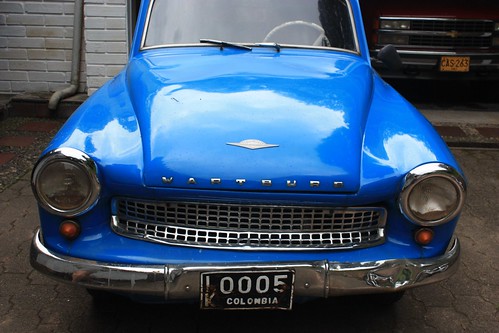

Roberto, who used to be a world class cyclist and trained the Colombian Tour de France team, even showed off a bike he owns that is made with gold parts. His proudest moment
seemed to be when he showed us the false bookcase with a safe room hidden behind it, where he happily posed for photos with the other tourists.

Then we sat down in his lounge and had the opportunity to question him. Our guide and driver told us to ask any question we wanted and to challenge his answers,
most of which they think are lies as his usual response is that they didn’t do something or the police did it to set them up. Among the many questions put to him, we asked him why did he blow up a plane of 300 innocent people,
does he regret being in the cocaine business and what was the worse thing he did in his time? He always gave unsatisfactory answers, but seemed to relish the attention he was
receiving. He enjoyed telling us tales about all the methods they used to smuggle cocaine into the United States and of his time hiding in the jungle with Pablo whilst trying to evade arrest. Our guide would translate our
questions to him but she had to shout because his hearing and eyesight are really bad as he was sent a letter bomb while he was in prison which exploded in his face.
All we could think about after our visit ended was what a sad old man he was, trying to make some money and have some fame as Pablo’s brother. The fact that he has recently
written a book that is available outside of Colombia, not inside, meant he was trying to promote himself, and now I've just done it for him! It seemed he never really was a major part of the clan because he probably wouldn’t be alive today. He thinks he is still alive because he gave himself up to the Cali cartel and provided them with inside information in exchange for a quiet life, a life where today he’s too scared to leave Colombia and hardly ever leaves his own house.
I was hesitant to go on the tour but I guess in the end Pablo Escobar was a huge part of Medellin’s and Colombia’s history. Meeting Roberto felt like being invited to meet Hitler’s or Al Capone’s brother, someone who
was part of something criminal and evil but something that has become important history that will not be forgotten in a hurry.
After that completely bizarre day, we were thankful for Medellin’s other attractions to take our minds of the Escobars and replace it with the world of all things plump
thanks to Botero’s works of art. Botero is one of Colombia’s most famous artists and the Museo de Antioquia and Medellin’s main plaza are surrounded by his bronze sculptures, where he likes to chubbify everything from
people, animals and everyday objects.


Medellin also has the worlds only metro cable car system linked to the underground metro. You can change platform on the metro and hop on a cable car, which travels for several
stations over the poorer slum area of Medellin and was a great way to view all aspects of the city.

After treating ourselves to a fancy meal for a friends birthday in one of the many great restaurants Medellin has to offer, we decided it was time to head
over to the Capital.
Bogota
We were pleasantly surprised by Bogota, yet another city with an undeservedly dodgy reputation. We weren’t looking forward to visiting the capital because we were enjoying
the countryside life in Colombia much more than it’s cities and because it also has the worst climate in the whole country being about 2800m above sea level with constant rain and cold days. However, it was a really charming
place and soon had us pronouncing it as our favourite colonial capital in South America. We stayed in La Candelaria district, the oldest part of the city, which is full of historical and important buildings surrounding the
Plaza de Bolivar, and also full of groups of school children trying not to lose each other.

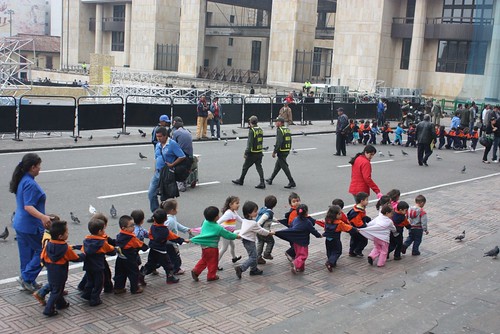
When the rain stops the first place to head is up the top of Monserrate mountain, where, if the clouds stay thin, you can just about make out a view of the city below.
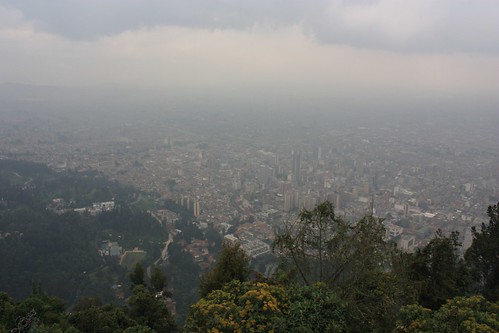
And who couldn’t love a city where there are countless confectionery shops selling calorific but delicious goodies to warm us up. If you remember our love for dulce de leche
in Argentina, you will be happy to know the Colombians eat the same gooey goodness but call it arequipe and is the main ingredient for most of the treats on offer.
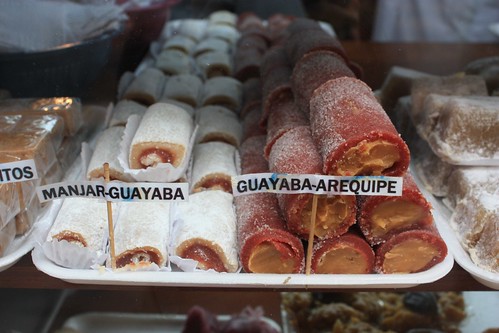
Choosing to stay in the Chocolate Hostel wasn’t going to make for a bad city experience either. They made us freshly melted hot chocolate for breakfast every morning, which
could only be a great way for us to start the day.

Bogota's most famous museum is the Museo de Oro, which is full of pre-Spanish gold artifacts made by the indigenous tribes that used to live in the region. There
were some very expensive and unique pieces on display behind a set of very thick and secure looking doors.
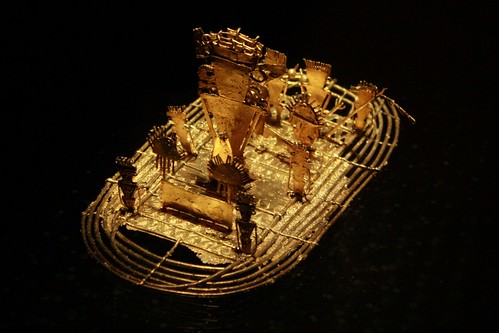
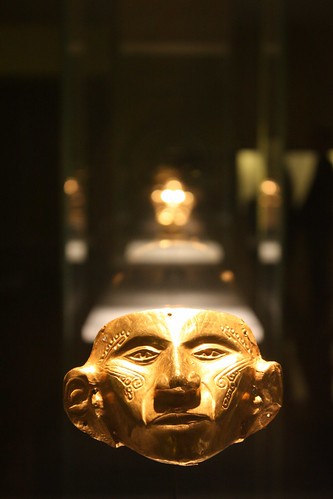
There are some excellent free art galleries in Bogota including another Botero museum, where you can see more of his famous pictures including a plump version of the Mona
Lisa.
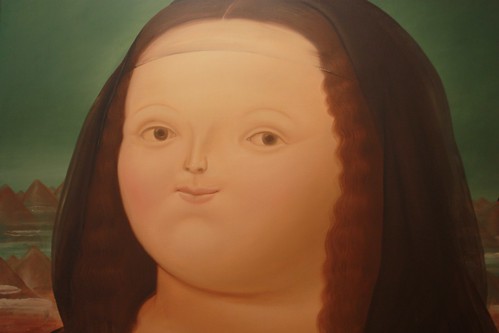
San Gil
After five days in Bogota we headed six hours north to San Gil which sits on the powerful River Fonce. Next to the river is the Parque El Gallineral that could be the setting for the Lord
of the Rings. It's full of bearded trees that give the forest a mystical, fairytale feel, where you almost expect to see elves roaming around and lost hobbits looking for somewhere to dispense their ring.
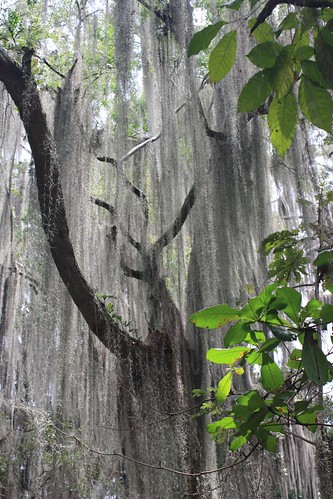
San Gil sits at a much lower altitude than we had been in for a while and along with the tropical climate we were greeted by the return of our old friend the gecko and the squeaky little chirrup they let off to let you
know they are around. Oh how we have missed that sound! We also experienced an odd breakfast custom. In the town’s main market, we ordered what we thought would be a healthy fruit salad but were presented with a heap of
chopped fruit topped with ice cream AND grated cheese. A slightly odd combo but it tasted good, so we weren’t complaining.
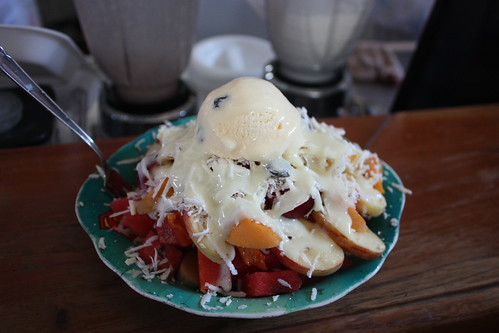
We also discovered San Gil is home to the best chicken restaurant in the whole of South America, and that is really saying something for a continent that adores its fried,
roasted, broasted or grilled pollo from chicken restaurants lined up along every street. I can’t remember the name of the place, but our exclamations of ‘muy rico y muy delicioso’ impressed the owner so much, he gave us a fridge
magnet as a present!
Barichara & Guane
Just half an hour by bus over the hills from San Gil is Colombia’s most filmed town because this very picturesque town has been restored to it’s cobble-stoned, red tiled,
white washed original colonial standards making it perfect to film the tv novelas that the Colombians love to watch. These are generally like soap operas but only run a for a year and you can often hear people gasping at the
tv each time there is a doof doof moment, it’s all very dramatic!

There is also an ancient stone road built by the Guane indigenous people linking Barichara to the tiny hamlet of Guane. The two hour walk, which we wouldn’t recommend doing
under the blazing midday sun, had beautiful scenery and the hamlet was equally rewarding.


Guane was a real one horse town, where the plaza doubles as the
school playground and the centre point of all local activity. The great thing about visiting plaza after plaza throughout South America is the insight it gives you into the cultures and customs of the people. The plazas are always full
of life whether it be families having an afternoon stroll and kids playing in the fountains, girls wandering around eyeing up the guys, old men playing chess and dominoes, ladies chatting away
to each other, food vendors on every corner selling the national snack and local fruit juice, business men getting their shoes shined by the shoeshine kids and that’s just to name a few sights you can see. One of the best tips we can give for
travelling in South America is to spend an hour sitting in the main plaza just to see what walks past.


After returning to San Gil for a day we decided it was finally time to head north to see the Mar Caribe (Caribbean Sea) for the very first time! Whoooo hoooooo, I’ve been longing for this
moment since Argentina, but will we enjoy it?
Until next time...
Jo y Ryan
Photos: http://www.flickr.com/photos/dojo77/